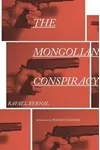Picture a Mexican storyteller who spun gritty crime tales and surreal jungle mysteries with equal flair—meet Rafael Bernal! A diplomat, journalist, and literary trailblazer, Bernal reshaped Mexican literature with his sharp wit and genre-bending novels. His masterpiece, The Mongolian Conspiracy, is a noir classic that pulses with political intrigue, while His Name Was Death dives into the bizarre. Ready to explore the world of this 20th-century icon?
The Making of Rafael Bernal
Born on June 28, 1915, in Mexico City’s vibrant Santa María la Ribera, Rafael Bernal was a polymath from the start. The great-grandson of historian Joaquín García Icazbalceta, he soaked up stories and ideas early on. Educated at the Colegio Francés de San Borja and later at Loyola College in Montreal, Bernal’s global perspective took root. By the 1930s, he was diving into philosophy and letters at Mexico’s Instituto de Ciencias y Letras, setting the stage for a life of words. His early career as a journalist for Excélsior and Novedades during World War II, followed by a stint as a Hollywood screenwriter, sharpened his knack for vivid storytelling.
Bernal’s diplomatic posts in Honduras, Peru, the Philippines, and Switzerland added layers to his worldview. Living in Chiapas in the 1940s, he was captivated by the jungle’s raw power, which later seeped into his fiction. His diverse path—part adventurer, part intellectual—gave his writing a unique edge, blending gritty realism with philosophical depth.
Rafael Bernal’s Unforgettable Stories
Bernal’s literary legacy hinges on his ability to reinvent genres. The Mongolian Conspiracy (1969) is his crown jewel, often hailed as the first true Mexican noir novel. It follows Filiberto García, a cynical ex-revolutionary turned hitman, unraveling a global plot in Mexico City’s Chinatown. Packed with dark humor and biting commentary on political corruption, it’s a thrilling ride that set the tone for Mexican crime fiction.
Then there’s His Name Was Death (1947), a surreal gem where a drunken loner in Chiapas decodes mosquito language to chilling ends. This eco-fiction precursor blends science fiction and existential dread, showcasing Bernal’s wild imagination. Other works, like Caribal: The Green Hell (1954), explore the jungle’s untamed heart, while México en Filipinas (1965) reflects his diplomatic insights into cultural exchange. Bernal’s style—sharp, atmospheric, and often darkly funny—wrestles with themes of failure, nature, and Mexico’s post-revolutionary soul.
His versatility shone in poetry, plays, and essays too. His play La Carta made history as Mexico’s first televised drama in 1950, proving his knack for embracing new mediums. Whether crafting detective tales or historical studies, Bernal’s voice was always distinctly his own.
Why Rafael Bernal Matters
Bernal’s impact on Mexican literature is undeniable. The Mongolian Conspiracy didn’t just launch a genre—it captured the disillusionment of a nation grappling with political decay. Critics like Paco Ignacio Taibo II call it a cornerstone of Latin American noir, its influence echoing in modern crime fiction. Bernal’s ability to weave social critique into pulpy plots made his work timeless, resonating with readers who crave stories with bite.
His lesser-known works, like His Name Was Death, foreshadowed eco-fiction and speculative genres, proving his foresight. As a diplomat, he bridged cultures, and as a writer, he gave Mexico a literary identity that was both local and universal. Though undercelebrated globally, Bernal remains a cult figure in Mexico, his books still sparking comic adaptations and films.
- Born: June 28, 1915, Mexico City
- Died: September 17, 1972, Bern, Switzerland
- Key Works: The Mongolian Conspiracy, His Name Was Death, Caribal
- Awards: Two Flores Naturales for poetry
Snag The Mongolian Conspiracy and dive into Rafael Bernal’s thrilling, shadowy world!

